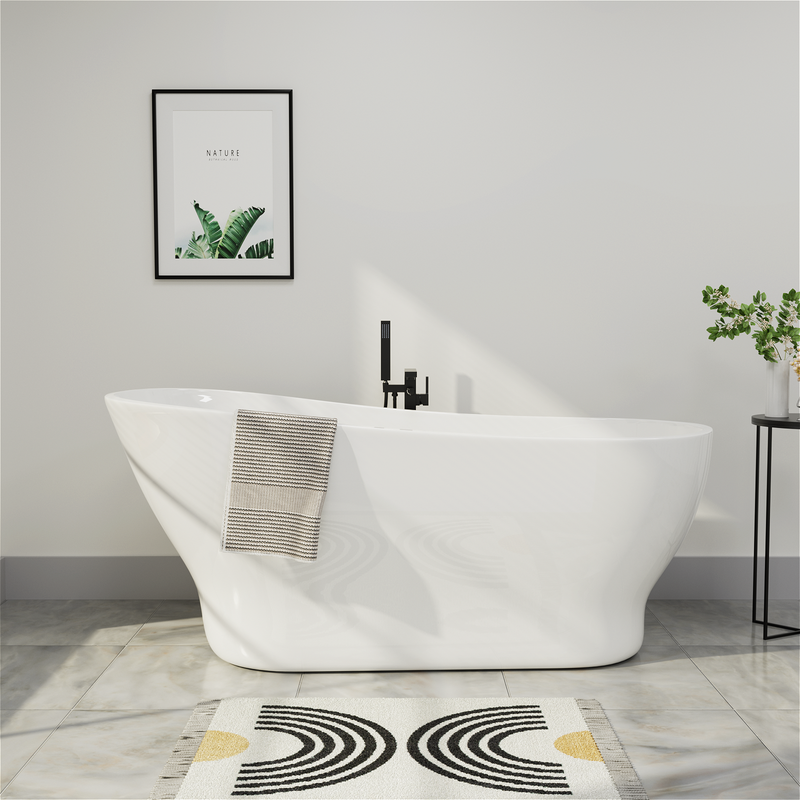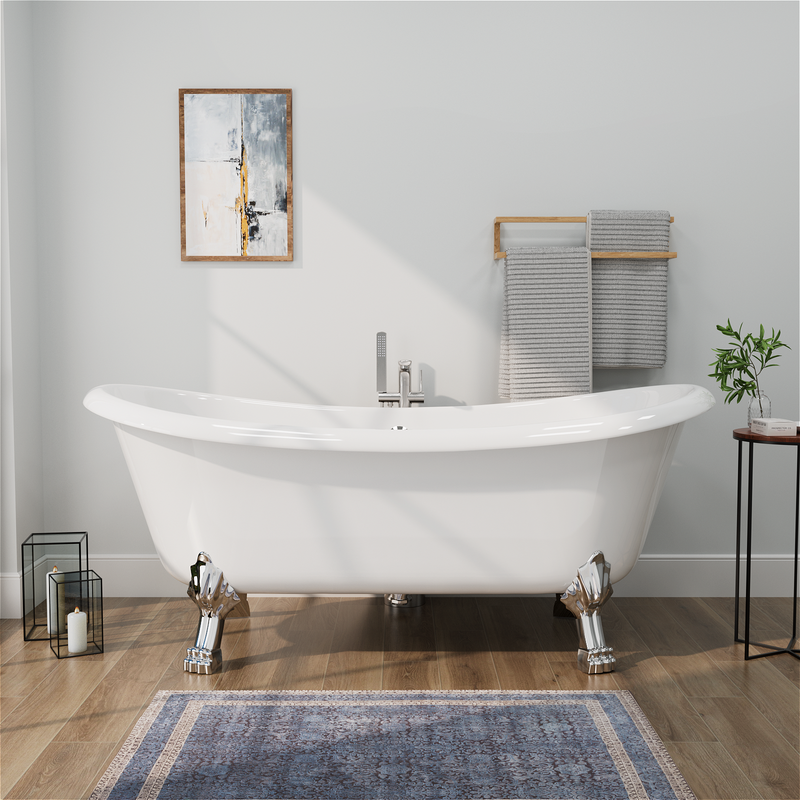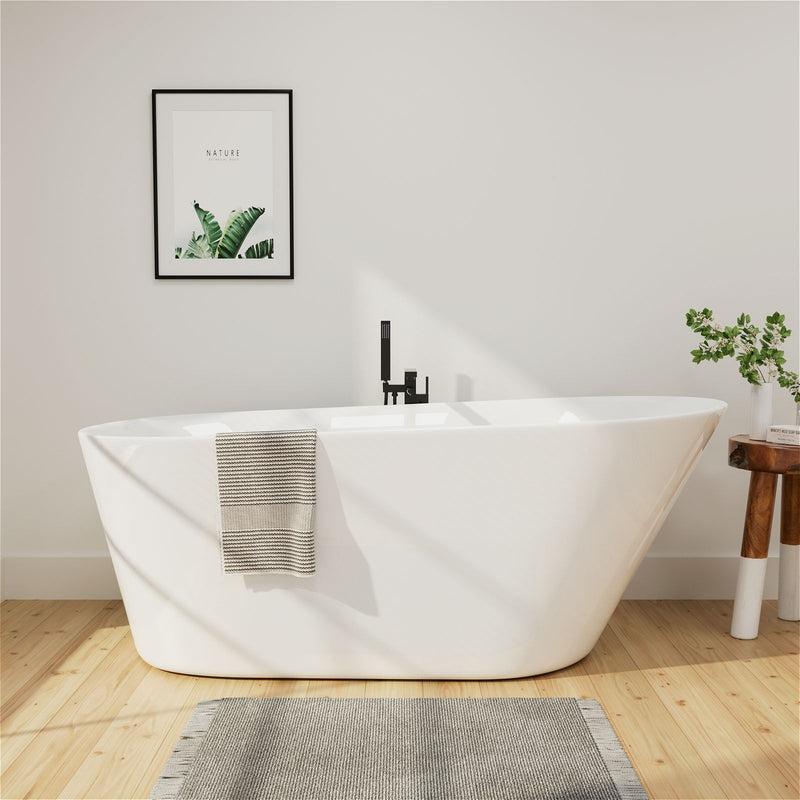The freestanding bathtub has become an iconic symbol of bathroom luxury, gracing home design magazines and renovation shows with its elegant profiles. These beautiful fixtures make a dramatic style statement, transforming ordinary bathrooms into visually striking spaces. But beyond their undeniable aesthetic appeal, many homeowners wonder whether freestanding bathtubs are worth it from a practical and financial perspective.
The decision to install a freestanding bathtub involves careful consideration of costs, space requirements, and daily functionality. Unlike drop-in tubs that blend seamlessly into the bathroom structure, freestanding tubs demand both floor space and a significant budget. Understanding the true investment required—not just in the tub itself but in installation, plumbing adjustments, and potential bathroom modifications—is essential before making this design choice.
This guide examines every aspect of freestanding bathtub ownership, from the tangible freestanding bathtub benefits to the practical challenges. We'll break down the real costs, explore solutions to common concerns like water splashing, and help you determine whether your home and lifestyle are well-suited to this beautiful but demanding bathroom centerpiece.
Addressing Common Concerns About Freestanding Bathtubs
Cost Apprehensions
The financial aspect of freestanding bathtubs represents the most significant barrier for many homeowners. Unlike standard built-in tubs, freestanding bathtubs carry higher price tags both for the fixtures themselves and their installation. The bathtub alone typically ranges from $500 to $15,000 depending on materials, size, and brand, with premium materials like cast iron and solid surface commanding the highest prices.

Installation expenses add substantially to the initial outlay, typically costing between $1,000 and $6,000 depending on your bathroom's existing plumbing and layout. This investment extends beyond the tub itself to include potential floor reinforcement, plumbing modifications, and the purchase of specialized faucets that must be factored into your budget.
Space Considerations
Many homeowners with standard-sized bathrooms worry that a freestanding tub will overwhelm their limited square footage. These fixtures generally require more floor space than built-in bathtubs since they need clearance on all sides for both aesthetic appeal and practical access. The space around the tub for cleaning and movement should also be considered in your layout planning.
In very compact bathrooms, freestanding tubs might not represent the most space-efficient choice. However, strategically selected smaller bathtubs can work well if carefully positioned. Some homeowners find that replacing a bulky shower-tub combination with a standalone tub actually creates a more open feel, as the visible floor space beneath and around the tub can make the room appear larger.
Practical Usage Worries
Beyond cost and space, practical concerns about daily use give many homeowners pause. Questions about water splashing outside the tub, cleaning difficulties around and beneath the fixture, and overall maintenance requirements are common among those considering freestanding tubs.
The reality is that freestanding tubs do present some practical challenges compared to their built-in counterparts. Without surrounding walls to contain splashes, water can more easily reach other bathroom surfaces. Cleaning around and underneath the tub requires more effort than cleaning a built-in bathtub, and some users find getting in and out of a freestanding tub less stable without nearby walls for support.
The Advantages of Freestanding Bathtubs
Design Flexibility and Aesthetic Appeal
The most compelling advantage of freestanding bathtubs remains their striking visual impact. These fixtures serve as natural focal points that can elevate the entire bathroom's design scheme. Available in an astonishing variety of shapes—from classic oval and rectangular to contemporary organic forms—freestanding tubs offer design possibilities that built-in bathtubs simply cannot match.
This design flexibility extends to placement options as well. Unlike built-in tubs that must be positioned against walls, freestanding bathtubs can be installed virtually anywhere plumbing connections can be established. This allows for creative layouts, such as centering the tub beneath a window or angling it in a corner to improve traffic flow. The ability to see the tub from all sides means that every aspect of its design contributes to the bathroom's overall aesthetic.
Potential Property Value Enhancement
Well-chosen freestanding bathtubs can positively impact your home's value by creating a high-end impression that appeals to potential buyers. While not all home purchasers prioritize bath fixtures, the dramatic statement of a freestanding tub often contributes to a sense of luxury that can make your property more memorable in competitive markets.
Real estate professionals note that bathroom renovations typically offer good return on investment, with premium features like freestanding tubs potentially increasing appeal to buyers who appreciate upgraded spaces. However, this value enhancement depends on your local market and the overall quality of the installation—an inappropriately sized or poorly installed tub in a cramped bathroom could potentially detract from rather than enhance value.
Enhanced Bathing Experience
From a practical usage perspective, freestanding tubs often provide a more comfortable and immersive bathing experience than standard built-in bathtubs. Many are designed specifically for deep soaking, with greater water depth that allows most adults to submerge up to their shoulders. The absence of surrounding walls creates an open, airy feeling that many bathers find more relaxing than the enclosed experience of a built-in tub.

The ergonomic designs of many freestanding tubs further enhance comfort. Oval and rounded forms often feature contours that better support the body's natural shape, while slipper styles with raised ends provide excellent back and head support for reclining comfortably during long soaks.
Real Cost Breakdown of Freestanding Bathtubs
Tub Materials and Price Ranges
The material of your freestanding tub represents the most significant factor in its cost, with options available at various price points:
- Acrylic: These tubs typically range from $500 to $2,500, offering an affordable yet durable option with excellent heat retention properties. Acrylic is lightweight, warm to the touch, and available in numerous shapes and styles.
- Cast Iron: At $1,500 to $5,000+, these premium tubs offer exceptional durability and heat retention but require strong structural support due to their significant weight.
- Solid Surface: These tubs fall in the $2,000 to $6,000+ range, offering a luxurious appearance and non-porous surface that resists staining.
- Stone Resin: Costing between $1,000 and $4,000, these tubs provide the aesthetic appeal of natural stone with consistent coloring and good durability.
Installation Expenses
Installation costs for freestanding tubs vary significantly based on your bathroom's existing conditions and the complexity of the project:
- Basic installation with no plumbing modifications: $500-$1,500
- Standard installation including plumbing adjustments and floor reinforcement: $1,500-$3,000
- Complex installation requiring bathroom reconfiguration or structural changes: $3,000-$6,000+
The freestanding nature of these tubs often requires specific plumbing solutions, including floor-mounted faucets that typically cost $200-$800. If your installation requires moving drain lines or water supply pipes, expect to pay additional plumbing fees of $500-$2,000 depending on the complexity of the work.
Additional Cost Factors
Beyond the tub and basic installation, several additional expenses should factor into your budget:
- Water heating: The larger water capacity of many freestanding tubs may require upgrading your water heater, costing $500-$1,500+.
- Flooring: You may need to repair or replace flooring where a previous built-in tub was removed, typically $300-$1,000.
- Water usage: Filling a large soaking tub consumes more water than standard tubs, potentially increasing your water bill.
Space Planning and Splash Management Solutions
Effective Layout Strategies for Various Bathroom Sizes
Successful integration of a freestanding tub depends largely on thoughtful space planning. For smaller bathrooms, consider compact tubs measuring 55-65 inches long rather than standard 70-75 inch bathtubs. Positioning the tub against a wall or in a corner can conserve space while maintaining its visual impact.
Many homeowners don't realize that the visible floor space around a freestanding tub can actually make a small bathroom appear larger. The continuous flooring flowing beneath the tub creates an expanded visual field that often makes the room feel more spacious than one with a built-in tub surrounded by walls.

In bathrooms where every inch counts, consider oval or round tubs that may fit better in awkward spaces than rectangular bathtubs. The curved sides can make movement around the tub easier in tight quarters.
Practical Splash Containment Approaches
Water splashing represents a legitimate concern with freestanding tubs, particularly in compact bathrooms where fixtures sit in close proximity. Several practical strategies can help manage this issue:
- Strategic placement: Position the tub away from vulnerable elements like wooden cabinets or electrical outlets.
- Bath rugs: Place absorbent mats on high-splash areas around the tub to protect flooring.
- Shower combinations: For tub-shower combos, ensure your shower curtain rod extends sufficiently beyond the tub perimeter (6-12 inches recommended) and use a weighted curtain or inner liner to prevent escaping spray.
- Careful bathing: Adjust your bathing style to minimize vigorous movements that create splashing.
Regular use of a bath mat when entering and exiting the tub will also help contain drips on surrounding floors.
Ideal Households for Freestanding Bathtubs
Homeowners Who Will Benefit Most
Freestanding tubs work particularly well for certain household types and situations:
- Empty nesters and couples without small children typically have more flexibility for bathroom design and can better maintain the aesthetic appeal of a freestanding tub.
- Households with a secondary bathroom can dedicate one bathroom to luxury bathing while maintaining practical shower facilities in another.
- Personal wellness enthusiasts who value extended soaking as part of their self-care routine will appreciate the comfortable, immersive experience.
- Homeowners not planning immediate resale can enjoy the tub without worrying about its specific impact on property value.
- Those with medium to large bathrooms have sufficient space to accommodate the tub without compromising functionality.
When to Consider Alternatives
Despite their appeal, freestanding tubs may not be ideal for every situation:
- Families with young children often find built-in tubs safer and more practical for bathing children.
- Households with mobility challenges may require the support bars and stable entry of built-in tubs.
- Extremely small bathrooms might not accommodate a freestanding tub without sacrificing essential functionality.
- Strict budgets may be better served with a quality built-in tub that leaves more funds for other renovations.
- Rental properties may not benefit from the premium investment of a freestanding tub.
Real-World User Experiences
Positive Experiences and Satisfactions
Homeowners who are happy with their freestanding tub decision frequently mention several key satisfactions. Many note the daily aesthetic pleasure their tub brings, with its sculptural presence enhancing their bathroom experience long after the renovation is complete. The quality of soaking receives frequent praise, with users appreciating the deeper immersion and more comfortable positioning possible in tubs designed specifically for relaxation rather than simple utility.

Those who have upgraded from standard built-in tubs often comment on how the open sight lines around the freestanding tub make their bathroom feel more spacious and airy. The design flexibility also earns positive mentions, with homeowners appreciating the ability to choose a tub that reflects their personal style rather than being limited to standard alcove dimensions.
Challenges and Regrets
Less satisfied users typically cite specific practical issues with their freestanding tubs. Cleaning difficulties around and beneath the tub represent the most common complaint, with many underestimating the maintenance required to keep the area looking its best. Water temperature maintenance can be an issue in some bathtubs, though proper material selection (such as acrylic with good heat retention) largely addresses this concern.
Some homeowners regret their tub's size in relation to their bathroom, either choosing one too large for comfortable movement or too small for satisfying soaks. Others mention installation complications that increased their project costs beyond initial estimates, particularly when dealing with older homes requiring plumbing updates or floor reinforcement.
Making Your Decision
The question of whether a freestanding bathtub is worth the investment ultimately depends on your specific circumstances, priorities, and lifestyle. These beautiful fixtures offer undeniable aesthetic appeal and can transform an ordinary bathroom into a striking space, but they require careful consideration of costs, space, and practical maintenance.
If you value design statement over strict practicality, have sufficient budget for both quality materials and professional installation, and your household composition allows for enjoying long, undisturbed soaks, a freestanding tub may be an excellent addition to your home. However, if your bathroom space is extremely limited, your budget is tight, or your household includes small children or individuals with mobility challenges, a well-chosen built-in tub might serve your needs more effectively.
By honestly assessing how you use your bathroom daily, establishing a realistic budget that includes both the fixture and necessary installation work, and carefully measuring your space, you can determine whether a freestanding bathtub represents a worthwhile investment for your home and lifestyle.
FAQs
Q1: Are freestanding bathtubs actually more comfortable than built-in tubs?
A: Many users find freestanding tubs more comfortable due to their often deeper soaking depths and ergonomic shapes designed specifically for relaxation rather than utility. However, comfort is subjective, and those who prefer sitting upright rather than reclining may not experience the same benefit.
Q2: How difficult is it to clean around and under a freestanding tub?
A: Cleaning a freestanding tub requires more effort than cleaning a built-in bathtub. You'll need to clean both the tub itself and the floor around and beneath it. The accessible space underneath collects dust and requires regular attention, though the absence of corners where walls meet tub eliminates a common mold-prone area.
Q3: Can I add a shower to a freestanding bathtub?
A: Yes, freestanding tubs can be equipped with shower capabilities using a ceiling-mounted shower rod or circular enclosure. However, effective water containment requires careful planning, and you may need to waterproof surrounding walls and floors depending on your setup.
Q4: Do freestanding tubs need special plumbing arrangements?
A: Freestanding tubs often require specific plumbing solutions, typically including floor-mounted faucets rather than wall-mounted ones. The drain location may need adjustment from your previous setup, and supply lines must be run to the appropriate locations for your chosen faucet style.
Q5: Are freestanding tubs a good choice for small bathrooms?
A: Freestanding tubs can work in small bathrooms if you select a compact bathtub and position it strategically. Many homeowners find that the visible floor space around the tub actually makes small bathrooms appear larger, though very cramped spaces might still be better served with space-efficient built-in options.
Q6: How long do freestanding bathtubs typically last?
A: With proper care, quality freestanding tubs can last decades. Material selection significantly impacts longevity—cast iron tubs can last a lifetime with basic maintenance, while acrylic bathtubs typically provide 10-15 years of good service before potentially needing replacement or refinishing.
Q7: Do freestanding tubs hold heat better than built-in bathtubs?
A: Heat retention depends more on material than installation style. Acrylic and cast iron freestanding tubs typically provide excellent heat retention, often superior to steel built-in bathtubs. The thickness of the material significantly influences this property, with thicker walls generally providing better temperature maintenance.





